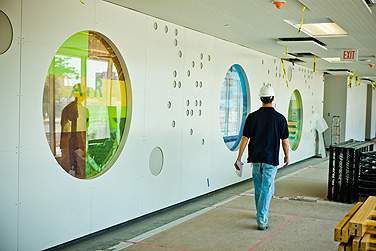News
UB opens state-of-the-art Greiner Hall

The entire first floor of Greiner Hall is dedicated to learning space. Photo: DOUGLAS LEVERE
Sustainable, Plyboo walls. Floor tiling made from recycled soda bottles. Man-made ponds designed to capture rainwater before it enters an overloaded sewer system. Electrical outlets high enough to be easily accessible to wheelchair users. Classrooms and lounges suitable for educational programs and social gatherings.
These are just a few of the cutting-edge features that make Greiner Hall, UB’s newest residence hall, a model for campus living.
To be dedicated on Aug. 19, the 198,500-square-foot building has capacity for 600 students, with suites featuring two double rooms with an adjoining private bathroom and storage area. Additional amenities include wireless Internet access, a 50-seat Au Bon Pain café, multi-use classrooms, study spaces and fireplace lounges.
“Greiner Hall provides students with a living environment that supports their intellectual pursuits and creates opportunities to socialize and exchange ideas in a vibrant university setting,” says Dennis Black, UB vice president for university life and services.
Greiner Hall is reserved for sophomores, who often seek greater privacy and more space as they enter their second year of college.
The building’s blend of residential, recreational and academic spaces creates a vibrant living and learning environment for these students, encouraging them to remain engaged in academics as they continue their education. The facility embodies the “learning landscape” concept in the university’s UB 2020 strategic plan, which encourages continual student learning by creating an environment that supports discovery outside the classroom.
Located on the North Campus adjacent to the Ellicott Complex, Greiner Hall was designed to earn a gold rating under the U.S. Green Building Council’s Leadership in Energy and Environmental Design (LEED) rating system and to conform with best practices in universal design, which refers to the creation of buildings, products and services accessible to people of diverse abilities.
Greiner Hall is named for William R. Greiner, UB’s 13th president, who died in December 2009 due to complications from heart surgery. Greiner, who joined the UB Law faculty in 1967, rose through the faculty and administrative ranks, culminating with his appointment as UB's 13th president in 1991. He served through 2003, and was named UB president emeritus in 2009 by the SUNY Board of Trustees.
Greiner Hall stands in memory of Greiner’s 42 years of service to the university and his lifelong dedication to UB’s students.
The building’s many green features include:
- High-efficiency lighting and low-flow shower heads and faucets.
- A roof whose reflective, ultra-white coating helps keep the building cool.
- Showers for staff and faculty who work in Greiner Hall and commute to UB by bicycle.
- A landscaping irrigation system that draws water from a lake on campus.
- Walls made in part from Plyboo, a bamboo plywood material harvested from sustainable forests.
- Counters and flooring made from post-consumer materials.
- Detention ponds, called “bioswales,” that catch and maintain rainwater trickling from the roof and other hard surfaces, preventing the water from entering the sewer system.
The building’s many universally designed features include:
- Stoves, washers and dryers whose controls are easily accessible to wheelchair users.
- Electrical outlets high enough off the ground to ease accessibility for all users.
- Adaptable or accessible in-suite bathrooms that feature oversized showers to accommodate wheelchair users and others who need more space; some bathrooms have safety bars that people can grasp for support.
- High-contrast finishes on floors and walls in public areas to help people with poor eyesight distinguish between different spaces in the building.
The usability and effectiveness of Greiner Hall’s universally designed components will be tested as part of a research project that UB’s Center for Inclusive Design and Environmental Access (IDeA Center) is conducting with the goal of evaluating and improving new universal design standards for public buildings.
The study, part of UB’s Rehabilitation Engineering Research Center (RERC) on Universal Design in the Built Environment, funded by the National Institute on Disability and Rehabilitation Research, will survey current universal-design practices in architectural design. Results will help researchers develop an improved evidence base for universal-design standards.
Greiner Hall was constructed in partnership with the UB Foundation. Cannon Design served as the architectural and engineering firm on the $57 million project. Construction was managed by LPCiminelli.

Reader Comments